Exercises (3162)
Rotation of the upper body with extension and flexion of the arm while standing (left)
Power
Individual work


Stand upright, slightly turned to the side (right leg in front), arms bent and held high (elbows pointing downwards at chest height), extend the rear (left) arm forwards (hand edge downwards) and simultaneously turn the upper body (to the right), rotate the upper body as far as possible (outstretched arm 90 degrees to the front standing leg) and return to the starting position.
Attention:
Always keep your arms raised (hands at shoulder height).
Lighten:
smaller movements (less rotation).
Harden:
additional weight (on the arm(s), hold in the hand(s) or hold with both hands and stretch/flex both arms at the same time).
Variant:
Hold an additional weight (e.g. weight disc or dumbbell) in both hands and extend/flex the arms simultaneously while rotating the upper body.
2 weight cuffs/weight balls/dumbbells ► Make the exercise more difficult (additional weight)
1 weight disc ► Variation of the exercise
Rotation of the upper body with extension and flexion of the arm while standing (right)
Power
Individual work


Stand upright, slightly turned to the side (left leg in front), arms bent and held high (elbows pointing downwards at chest height), extend the back (right) arm forwards (hand edge downwards) and simultaneously turn the upper body (to the left), rotate the upper body as far as possible (outstretched arm 90 degrees to the front standing leg) and return to the starting position.
Attention:
Always keep your arms raised (hands at shoulder height).
Lighten:
smaller movements (less rotation).
Harden:
additional weight (on the arm(s), hold in the hand(s) or hold with both hands and stretch/flex both arms at the same time).
Variant:
Hold an additional weight (e.g. weight disc or dumbbell) in both hands and extend/flex the arms simultaneously while rotating the upper body.
2 weight cuffs/weight balls/dumbbells ► Make the exercise more difficult (additional weight)
1 weight disc ► Variation of the exercise
Rotation of the upper body with outstretched arms ► standing upper body rotation
Power
Individual work
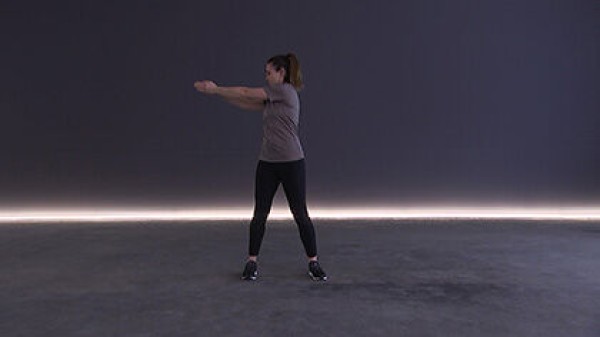
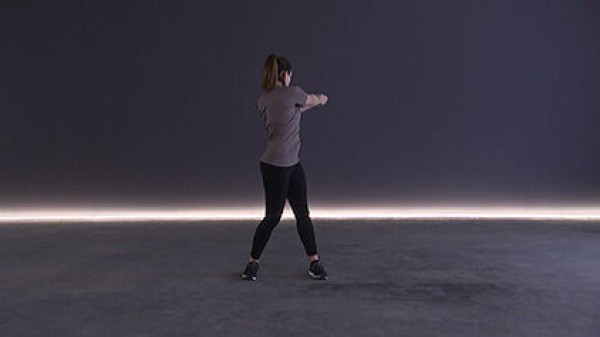
Stand upright, legs slightly wider than shoulder-width apart, arms outstretched in front of you (palms pressed together), move your upper body (arms) as far as possible from one side to the other.
Attention:
Always keep your arms in front of you (shoulder height).
Lighten:
Smaller movements (less rotation).
Harden:
Additional weight (hold on the arms or in the hands); unstable base.
2 weight cuffs/weight balls/1 weight disc/medicine ball/1-2 dumbbells ► Make the exercise more difficult (additional weight)
1-2 balance cushions/1 balance board ► Make the exercise more difficult (unstable surface)
Rotation of the upper body with legs crossed in push-up position ► twist push-up position
Power
Individual work



Push-up position (high support, face/look down), extend one leg under the body (crosswise) to the other side. Switch sides after each exercise.
Attention:
Stay stable (tense your stomach).
Lighten:
Just hold the basic position (push-up position); rotate your upper body less.
Harden:
Additional weight on the legs; unstable support for the arms.
Variant:
Underarm support (instead of push-up position).
2 weight cuffs ► to make the exercise more difficult (additional weight)
1 balance cushion/balance board ► to make the exercise more difficult (unstable surface)
Rotate the upper body and move the lower leg forwards in side plank (left) ► side plank crunch
Power
Individual work


Side support with outstretched (left) arm, the other arm bent and the hand placed next to the nearer ear, the body weight is supported only by the foot of the upper leg (right) and the arm (left), the other leg (left) is held slightly raised in front of the foot placed on the floor. Tighten the lower leg (left) and at the same time rotate/turn the upper body so that the elbows and knees are brought together crosswise. Then return to the starting position (straighten the leg again, rotate/turn the upper body back out).
Attention:
Head, torso, hips and knees practically form a line in the starting position (pelvis does not tilt backwards or forwards), keep the shoulder above the elbow; do not fully lower the free leg.
Lighten:
Lower the free leg (without bringing the elbow and knee together); lower the free leg after each movement; only hold the starting position.
Harden:
Additional weight (for the free leg).
Variation:
Lower foot placed on the floor with the outside instep and the upper leg brought to the elbow (free leg).
1 weight cuff/weight waistcoat ► Make the exercise more difficult (additional weight)
Rotate the upper body and move the lower leg forwards in side plank (right) ► side plank crunch
Power
Individual work


Side support with outstretched (right) arm, the other arm bent and the hand placed next to the nearer ear, the body weight is supported only by the foot of the upper leg (left) and the arm (right), the other leg (right) is held slightly raised in front of the foot placed on the floor. Tighten the lower leg (right) and at the same time rotate/turn the upper body so that the elbows and knees are brought together crosswise. Then return to the starting position (straighten the leg again, rotate/untwist the upper body back).
Attention:
Head, torso, hips and knees practically form a line in the starting position (pelvis does not tilt backwards or forwards), keep the shoulder above the elbow; do not fully lower the free leg.
Lighten:
Lower the free leg (without bringing the elbow and knee together); lower the free leg after each movement; only hold the starting position.
Harden:
Additional weight (for the free leg).
Variation:
Lower foot placed on the floor with the outside instep and the upper leg brought to the elbow (free leg).
1 weight cuff/weight waistcoat ► Make the exercise more difficult (additional weight)
Back turning
Fighting and roughhousing games
Partner work
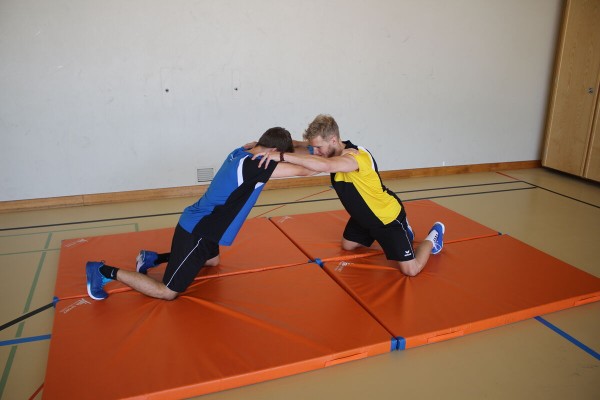
Two participants kneel down in the centre of a mat/grass field and grab each other by the shoulders. Both participants try to push and pull their opponent onto the mat/ground with their backs. The participant who first touches the mat/turf with both shoulders at the same time loses.
4-6 soft mats (small) ► indoor version
4 cones ► outdoor version
Indoor post set-up:
Using soft mats to form a rectangular field of mats.
Outdoor post set-up:
Using cones to define a rectangular field.
Supine position
Coordination exercises
Individual work
Back position on the slackline. Place one foot on the line close to the buttocks and use the other leg and arms to balance. Raise your head slightly so that you can look forwards to a fixed point. The slackline runs alongside the spine.
Lighten the load:
Do not stretch the slackline too tightly; support yourself on the ground with your arms.
Lighten the load:
Rise from a prone position over the seat to stand upright, hooking onto the slackline from below with your outstretched leg and pulling yourself up with momentum.
1 Slackline
Back thrust
Fighting and roughhousing games
Partner work
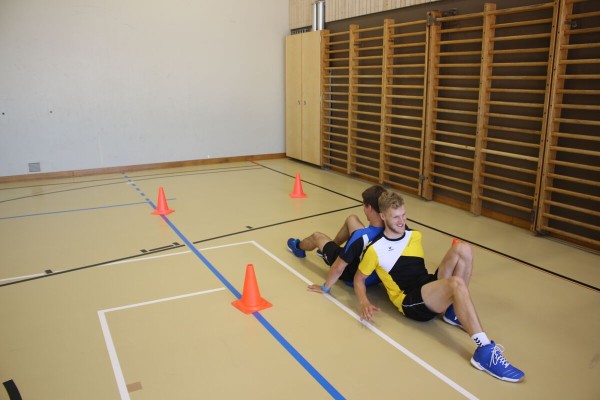
Two participants sit back to back on a centre line marked with cones. On command, both participants try to push their opponent over their baseline (marked with cones). The first person to cross their own line with their whole body loses.
6 marking cones/caps (optional) ►Playing field markings
Post setup:
Place the caps in a rectangle so that they define the centre line and two baselines of the playing field.
Rowing
Stimulate circulation
Individual work
A rowing machine is suitable for training strength, endurance and coordination, thus challenging the entire body. The correct technique is particularly important: an upright posture when rowing, the feet must find a secure hold in the footboard of the rowing machine and, ideally, the hips, knees and feet should form a line. More details on how to perform the movement are listed below. When distributing the force on the rowing machine, 60% comes from the legs, 30% from the core and only 10% from the arms. In this way, around 80 per cent of the muscle groups in the body are trained in a gentle way. This holistic workout makes rowing ideal for warming up your circulation (choose a moderate speed).
Movement execution:
In a seated position with bent legs and arms stretched forwards, first push off and stretch your legs, then pull your arms towards your head with your upper body tilted slightly backwards. Return to the starting position in exactly the opposite way: first stretch your arms, then move your upper body forwards and finally pull your legs forwards. In theory, the rowing movement sequence sounds complicated, but many of the individual movement sequences are already performed correctly unconsciously:
Starting position:
- Upper body bent forwards towards the thighs.
- Back muscles relaxed.
- Lower back straight, upper back (trapezius muscle) may make a slight hump.
- Arms stretched (triceps remain relaxed).
- Tummy muscles slightly tensed.
Starting the pull-through:
- Legs lead the movement by stretching them.
- At the same time as stretching your legs, slightly tense your lower back and bring it into a straight position.
- The phase ends when your legs are almost fully extended.
Middle phase of the pull-through:
- From this phase, the upper body also comes into play.
- The arms and back now dictate the movement, with both parts of the body being pulled backwards almost simultaneously (between the chest and belly button). The strength comes from the back and not the arms.
- The abdominal muscles and thigh muscles remain tensed the whole time.
- The phase ends with the upper body leaning slightly backwards and the arms slightly raised. The back shoulder is already working slightly.
Final move:
- Pull your arms completely towards your body.
- The upper body leans back a little further in the same move. The back shoulder is now even more involved.
- Tighten all the muscles involved (buttocks, thighs, abdomen, arms and shoulders).
Rolling:
- Arms lead the way.
- Stretch your arms forwards again. The upper body and legs follow the arms.
- The buttocks pull the seat forwards.
- The phase ends in the starting position.
1 rowing machine
Rowing
Increase pulse
Individual work
A rowing machine is suitable for training strength, endurance and coordination, thus challenging the entire body. The correct technique is particularly important: an upright posture when rowing, the feet must find a secure hold in the footboard of the rowing machine and, ideally, the hips, knees and feet should form a line. More details on how to perform the movement are listed below. When distributing the force on the rowing machine, 60% comes from the legs, 30% from the torso and only 10% from the arms. In this way, around 80 per cent of the muscle groups in the body are trained in a gentle way. This holistic workout makes rowing ideal for getting the heart rate up at the end of the warm-up. A high basic speed can be selected or constant changes of pace provide the necessary intensity.
Movement execution:
In a seated position with bent legs and arms stretched forwards, the legs are pushed down and stretched first, then the arms are pulled towards the head with the upper body tilted slightly backwards. Return to the starting position in exactly the opposite way: first stretch your arms, then move your upper body forwards and finally pull your legs forwards. In theory, the rowing movement sequence sounds complicated, but many of the individual movement sequences are already performed correctly unconsciously:
Starting position:
- Upper body bent forwards towards the thighs.
- Back muscles relaxed.
- Lower back straight, upper back (trapezius muscle) may make a slight hump.
- Arms stretched (triceps remain relaxed).
- Tummy muscles slightly tensed.
Starting the pull-through:
- Legs lead the movement by stretching them.
- At the same time as stretching your legs, slightly tense your lower back and bring it into a straight position.
- The phase ends when your legs are almost fully extended.
Middle phase of the pull-through:
- From this phase, the upper body also comes into play.
- The arms and back now dictate the movement, with both parts of the body being pulled backwards almost simultaneously (between the chest and belly button). The strength comes from the back and not the arms.
- The abdominal muscles and thigh muscles remain tensed the whole time.
- The phase ends with the upper body leaning slightly backwards and the arms slightly raised. The back shoulder is already working slightly.
Final move:
- Pull your arms completely towards your body.
- The upper body leans back a little further in the same move. The back shoulder is now even more involved.
- Tighten all the muscles involved (buttocks, thighs, abdomen, arms and shoulders).
Rolling:
- Arms lead the way.
- Stretch your arms forwards again. The upper body and legs follow the arms.
- The buttocks pull the seat forwards.
- The phase ends in the starting position.
1 rowing machine
Rowing (m: 1000m/1km - 80cal; w: 800m - 60cal) ► row
Power
Individual work



Sitting with your legs bent and arms stretched forwards, first push off and stretch your legs, then pull your arms towards your head with your upper body leaning slightly backwards. Return to the starting position in exactly the opposite way: first stretch your arms, then move your upper body forwards and finally pull your legs forwards. In theory, the rowing movement sequence sounds complicated, but many of the individual movement sequences are already performed correctly unconsciously:
Starting position:
Upper body bent forwards towards the thighs.
Back muscles relaxed.
Lower back straight, upper back (trapezius muscle) may make a slight hump.
Arms stretched (triceps remain relaxed).
Tummy muscles slightly tensed.
Starting the pull-through:
Legs lead the movement by stretching them.
At the same time as stretching your legs, slightly tense your lower back and bring it into a straight position.
The phase ends when your legs are almost fully extended.
Middle phase of the pull-through:
From this phase, the upper body also comes into play.
The arms and back now dictate the movement, with both parts of the body being pulled backwards almost simultaneously (between the chest and belly button). The strength comes from the back and not the arms.
The abdominal muscles and thigh muscles remain tensed the whole time.
The phase ends with the upper body leaning slightly backwards and the arms slightly raised. The back shoulder is already working slightly.
Final move:
Pull your arms completely towards your body.
The upper body leans back a little further in the same move. The back shoulder is now even more involved.
Tighten all the muscles involved (buttocks, thighs, abdomen, arms and shoulders).
Rolling:
Arms lead the way.
Stretch your arms forwards again. The upper body and legs follow the arms.
The buttocks pull the seat forwards.
The phase ends in the starting position.
1 rowing machine
Rudern (m: 1250m/1.25km - 100kal; w: 1000m/1km - 75kal) ► row
Power
Individual work



Sitting with your legs bent and arms stretched forwards, first push off and stretch your legs, then pull your arms towards your head with your upper body leaning slightly backwards. Return to the starting position in exactly the opposite way: first stretch your arms, then move your upper body forwards and finally pull your legs forwards. In theory, the rowing movement sequence sounds complicated, but many of the individual movement sequences are already performed correctly unconsciously:
Starting position:
Upper body bent forwards towards the thighs.
Back muscles relaxed.
Lower back straight, upper back (trapezius muscle) may make a slight hump.
Arms stretched (triceps remain relaxed).
Tummy muscles slightly tensed.
Starting the pull-through:
Legs lead the movement by stretching them.
At the same time as stretching your legs, slightly tense your lower back and bring it into a straight position.
The phase ends when your legs are almost fully extended.
Middle phase of the pull-through:
From this phase, the upper body also comes into play.
The arms and back now dictate the movement, with both parts of the body being pulled backwards almost simultaneously (between the chest and belly button). The strength comes from the back and not the arms.
The abdominal muscles and thigh muscles remain tensed the whole time.
The phase ends with the upper body leaning slightly backwards and the arms slightly raised. The back shoulder is already working slightly.
Final move:
Pull your arms completely towards your body.
The upper body leans back a little further in the same move. The back shoulder is now even more involved.
Tighten all the muscles involved (buttocks, thighs, abdomen, arms and shoulders).
Rolling:
Arms lead the way.
Stretch your arms forwards again. The upper body and legs follow the arms.
The buttocks pull the seat forwards.
The phase ends in the starting position.
1 rowing machine
Rowing (m: 125m - 10cal; w: 100m - 7cal) ► row
Power
Individual work
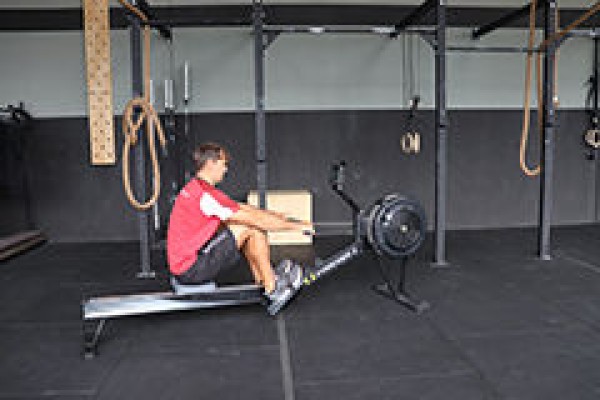


Sitting with your legs bent and arms stretched forwards, first push off and stretch your legs, then pull your arms towards your head with your upper body leaning slightly backwards. Return to the starting position in exactly the opposite way: first stretch your arms, then move your upper body forwards and finally pull your legs forwards. In theory, the rowing movement sequence sounds complicated, but many of the individual movement sequences are already performed correctly unconsciously:
Starting position:
Upper body bent forwards towards the thighs.
Back muscles relaxed.
Lower back straight, upper back (trapezius muscle) may make a slight hump.
Arms stretched (triceps remain relaxed).
Tummy muscles slightly tensed.
Starting the pull-through:
Legs lead the movement by stretching them.
At the same time as stretching your legs, slightly tense your lower back and bring it into a straight position.
The phase ends when your legs are almost fully extended.
Middle phase of the pull-through:
From this phase, the upper body also comes into play.
The arms and back now dictate the movement, with both parts of the body being pulled backwards almost simultaneously (between the chest and belly button). The strength comes from the back and not the arms.
The abdominal muscles and thigh muscles remain tensed the whole time.
The phase ends with the upper body leaning slightly backwards and the arms slightly raised. The back shoulder is already working slightly.
Final move:
Pull your arms completely towards your body.
The upper body leans back a little further in the same move. The back shoulder is now even more involved.
Tighten all the muscles involved (buttocks, thighs, abdomen, arms and shoulders).
Rolling:
Arms lead the way.
Stretch your arms forwards again. The upper body and legs follow the arms.
The buttocks pull the seat forwards.
The phase ends in the starting position.
1 rowing machine
Rowing (m: 2000m/2km - 160cal; w: 1600m/1.6km - 128cal) ► row
Power
Individual work



Sitting with your legs bent and arms stretched forwards, first push off and stretch your legs, then pull your arms towards your head with your upper body leaning slightly backwards. Return to the starting position in exactly the opposite way: first stretch your arms, then move your upper body forwards and finally pull your legs forwards. In theory, the rowing movement sequence sounds complicated, but many of the individual movement sequences are already performed correctly unconsciously:
Starting position:
Upper body bent forwards towards the thighs.
Back muscles relaxed.
Lower back straight, upper back (trapezius muscle) may make a slight hump.
Arms stretched (triceps remain relaxed).
Tummy muscles slightly tensed.
Starting the pull-through:
Legs lead the movement by stretching them.
At the same time as stretching your legs, slightly tense your lower back and bring it into a straight position.
The phase ends when your legs are almost fully extended.
Middle phase of the pull-through:
From this phase, the upper body also comes into play.
The arms and back now dictate the movement, with both parts of the body being pulled backwards almost simultaneously (between the chest and belly button). The strength comes from the back and not the arms.
The abdominal muscles and thigh muscles remain tensed the whole time.
The phase ends with the upper body leaning slightly backwards and the arms slightly raised. The back shoulder is already working slightly.
Final move:
Pull your arms completely towards your body.
The upper body leans back a little further in the same move. The back shoulder is now even more involved.
Tighten all the muscles involved (buttocks, thighs, abdomen, arms and shoulders).
Rolling:
Arms lead the way.
Stretch your arms forwards again. The upper body and legs follow the arms.
The buttocks pull the seat forwards.
The phase ends in the starting position.
1 rowing machine
Rowing (m: 200m - 15cal; w: 150m - 12cal) ► row
Power
Individual work

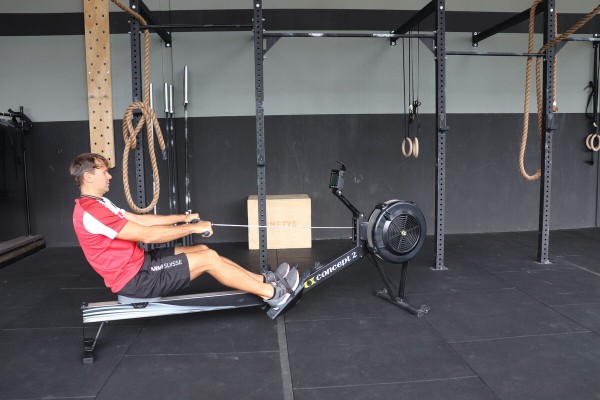
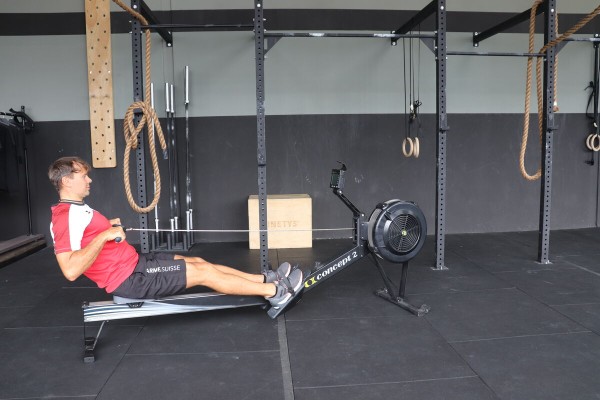
Sitting with your legs bent and arms stretched forwards, first push off and stretch your legs, then pull your arms towards your head with your upper body leaning slightly backwards. Return to the starting position in exactly the opposite way: first stretch your arms, then move your upper body forwards and finally pull your legs forwards. In theory, the rowing movement sequence sounds complicated, but many of the individual movement sequences are already performed correctly unconsciously:
Starting position:
Upper body bent forwards towards the thighs.
Back muscles relaxed.
Lower back straight, upper back (trapezius muscle) may make a slight hump.
Arms stretched (triceps remain relaxed).
Tummy muscles slightly tensed.
Starting the pull-through:
Legs lead the movement by stretching them.
At the same time as stretching your legs, slightly tense your lower back and bring it into a straight position.
The phase ends when your legs are almost fully extended.
Middle phase of the pull-through:
From this phase, the upper body also comes into play.
The arms and back now dictate the movement, with both parts of the body being pulled backwards almost simultaneously (between the chest and belly button). The strength comes from the back and not the arms.
The abdominal muscles and thigh muscles remain tensed the whole time.
The phase ends with the upper body leaning slightly backwards and the arms slightly raised. The back shoulder is already working slightly.
Final move:
Pull your arms completely towards your body.
The upper body leans back a little further in the same move. The back shoulder is now even more involved.
Tighten all the muscles involved (buttocks, thighs, abdomen, arms and shoulders).
Rolling:
Arms lead the way.
Stretch your arms forwards again. The upper body and legs follow the arms.
The buttocks pull the seat forwards.
The phase ends in the starting position.
1 rowing machine
Rowing (m: 250m - 20cal; w: 200m - 15cal) ► row
Power
Individual work



Sitting with your legs bent and arms stretched forwards, first push off and stretch your legs, then pull your arms towards your head with your upper body leaning slightly backwards. Return to the starting position in exactly the opposite way: first stretch your arms, then move your upper body forwards and finally pull your legs forwards. In theory, the rowing movement sequence sounds complicated, but many of the individual movement sequences are already performed correctly unconsciously:
Starting position:
Upper body bent forwards towards the thighs.
Back muscles relaxed.
Lower back straight, upper back (trapezius muscle) may make a slight hump.
Arms stretched (triceps remain relaxed).
Tummy muscles slightly tensed.
Starting the pull-through:
Legs lead the movement by stretching them.
At the same time as stretching your legs, slightly tense your lower back and bring it into a straight position.
The phase ends when your legs are almost fully extended.
Middle phase of the pull-through:
From this phase, the upper body also comes into play.
The arms and back now dictate the movement, with both parts of the body being pulled backwards almost simultaneously (between the chest and belly button). The strength comes from the back and not the arms.
The abdominal muscles and thigh muscles remain tensed the whole time.
The phase ends with the upper body leaning slightly backwards and the arms slightly raised. The back shoulder is already working slightly.
Final move:
Pull your arms completely towards your body.
The upper body leans back a little further in the same move. The back shoulder is now even more involved.
Tighten all the muscles involved (buttocks, thighs, abdomen, arms and shoulders).
Rolling:
Arms lead the way.
Stretch your arms forwards again. The upper body and legs follow the arms.
The buttocks pull the seat forwards.
The phase ends in the starting position.
1 rowing machine
Rowing (m: 375m - 30cal; w: 300m - 22cal) ► row
Power
Individual work



Sitting with your legs bent and arms stretched forwards, first push off and stretch your legs, then pull your arms towards your head with your upper body leaning slightly backwards. Return to the starting position in exactly the opposite way: first stretch your arms, then move your upper body forwards and finally pull your legs forwards. In theory, the rowing movement sequence sounds complicated, but many of the individual movement sequences are already performed correctly unconsciously:
Starting position:
Upper body bent forwards towards the thighs.
Back muscles relaxed.
Lower back straight, upper back (trapezius muscle) may make a slight hump.
Arms stretched (triceps remain relaxed).
Tummy muscles slightly tensed.
Starting the pull-through:
Legs lead the movement by stretching them.
At the same time as stretching your legs, slightly tense your lower back and bring it into a straight position.
The phase ends when your legs are almost fully extended.
Middle phase of the pull-through:
From this phase, the upper body also comes into play.
The arms and back now dictate the movement, with both parts of the body being pulled backwards almost simultaneously (between the chest and belly button). The strength comes from the back and not the arms.
The abdominal muscles and thigh muscles remain tensed the whole time.
The phase ends with the upper body leaning slightly backwards and the arms slightly raised. The back shoulder is already working slightly.
Final move:
Pull your arms completely towards your body.
The upper body leans back a little further in the same move. The back shoulder is now even more involved.
Tighten all the muscles involved (buttocks, thighs, abdomen, arms and shoulders).
Rolling:
Arms lead the way.
Stretch your arms forwards again. The upper body and legs follow the arms.
The buttocks pull the seat forwards.
The phase ends in the starting position.
1 rowing machine
Rudern (m: 5000m/5km - 400kal; w: 4000m/4km - 300kal) ► row
Power
Individual work



Sitting with your legs bent and arms stretched forwards, first push off and stretch your legs, then pull your arms towards your head with your upper body leaning slightly backwards. Return to the starting position in exactly the opposite way: first stretch your arms, then move your upper body forwards and finally pull your legs forwards. In theory, the rowing movement sequence sounds complicated, but many of the individual movement sequences are already performed correctly unconsciously:
Starting position:
Upper body bent forwards towards the thighs.
Back muscles relaxed.
Lower back straight, upper back (trapezius muscle) may make a slight hump.
Arms stretched (triceps remain relaxed).
Tummy muscles slightly tensed.
Starting the pull-through:
Legs lead the movement by stretching them.
At the same time as stretching your legs, slightly tense your lower back and bring it into a straight position.
The phase ends when your legs are almost fully extended.
Middle phase of the pull-through:
From this phase, the upper body also comes into play.
The arms and back now dictate the movement, with both parts of the body being pulled backwards almost simultaneously (between the chest and belly button). The strength comes from the back and not the arms.
The abdominal muscles and thigh muscles remain tensed the whole time.
The phase ends with the upper body leaning slightly backwards and the arms slightly raised. The back shoulder is already working slightly.
Final move:
Pull your arms completely towards your body.
The upper body leans back a little further in the same move. The back shoulder is now even more involved.
Tighten all the muscles involved (buttocks, thighs, abdomen, arms and shoulders).
Rolling:
Arms lead the way.
Stretch your arms forwards again. The upper body and legs follow the arms.
The buttocks pull the seat forwards.
The phase ends in the starting position.
1 rowing machine
Rowing (m: 500m - 40cal; w: 400m - 30cal) ► row
Power
Individual work



Sitting with your legs bent and arms stretched forwards, first push off and stretch your legs, then pull your arms towards your head with your upper body leaning slightly backwards. Return to the starting position in exactly the opposite way: first stretch your arms, then move your upper body forwards and finally pull your legs forwards. In theory, the rowing movement sequence sounds complicated, but many of the individual movement sequences are already performed correctly unconsciously:
Starting position:
Upper body bent forwards towards the thighs.
Back muscles relaxed.
Lower back straight, upper back (trapezius muscle) may make a slight hump.
Arms stretched (triceps remain relaxed).
Tummy muscles slightly tensed.
Starting the pull-through:
Legs lead the movement by stretching them.
At the same time as stretching your legs, slightly tense your lower back and bring it into a straight position.
The phase ends when your legs are almost fully extended.
Middle phase of the pull-through:
From this phase, the upper body also comes into play.
The arms and back now dictate the movement, with both parts of the body being pulled backwards almost simultaneously (between the chest and belly button). The strength comes from the back and not the arms.
The abdominal muscles and thigh muscles remain tensed the whole time.
The phase ends with the upper body leaning slightly backwards and the arms slightly raised. The back shoulder is already working slightly.
Final move:
Pull your arms completely towards your body.
The upper body leans back a little further in the same move. The back shoulder is now even more involved.
Tighten all the muscles involved (buttocks, thighs, abdomen, arms and shoulders).
Rolling:
Arms lead the way.
Stretch your arms forwards again. The upper body and legs follow the arms.
The buttocks pull the seat forwards.
The phase ends in the starting position.
1 rowing machine
Rudern (m: 750m - 60kal; w: 600m - 45kal) ► row
Power
Individual work



Sitting with your legs bent and arms stretched forwards, first push off and stretch your legs, then pull your arms towards your head with your upper body leaning slightly backwards. Return to the starting position in exactly the opposite way: first stretch your arms, then move your upper body forwards and finally pull your legs forwards. In theory, the rowing movement sequence sounds complicated, but many of the individual movement sequences are already performed correctly unconsciously:
Starting position:
Upper body bent forwards towards the thighs.
Back muscles relaxed.
Lower back straight, upper back (trapezius muscle) may make a slight hump.
Arms stretched (triceps remain relaxed).
Tummy muscles slightly tensed.
Starting the pull-through:
Legs lead the movement by stretching them.
At the same time as stretching your legs, slightly tense your lower back and bring it into a straight position.
The phase ends when your legs are almost fully extended.
Middle phase of the pull-through:
From this phase, the upper body also comes into play.
The arms and back now dictate the movement, with both parts of the body being pulled backwards almost simultaneously (between the chest and belly button). The strength comes from the back and not the arms.
The abdominal muscles and thigh muscles remain tensed the whole time.
The phase ends with the upper body leaning slightly backwards and the arms slightly raised. The back shoulder is already working slightly.
Final move:
Pull your arms completely towards your body.
The upper body leans back a little further in the same move. The back shoulder is now even more involved.
Tighten all the muscles involved (buttocks, thighs, abdomen, arms and shoulders).
Rolling:
Arms lead the way.
Stretch your arms forwards again. The upper body and legs follow the arms.
The buttocks pull the seat forwards.
The phase ends in the starting position.
1 rowing machine
Rowing ► row
Power
Individual work



Sitting with your legs bent and arms stretched forwards, first push off and stretch your legs, then pull your arms towards your head with your upper body leaning slightly backwards. Return to the starting position in exactly the opposite way: first stretch your arms, then move your upper body forwards and finally pull your legs forwards. In theory, the rowing movement sequence sounds complicated, but many of the individual movement sequences are already performed correctly unconsciously:
Starting position:
Upper body bent forwards towards the thighs.
Back muscles relaxed.
Lower back straight, upper back (trapezius muscle) may make a slight hump.
Arms stretched (triceps remain relaxed).
Tummy muscles slightly tensed.
Starting the pull-through:
Legs lead the movement by stretching them.
At the same time as stretching your legs, slightly tense your lower back and bring it into a straight position.
The phase ends when your legs are almost fully extended.
Middle phase of the pull-through:
From this phase, the upper body also comes into play.
The arms and back now dictate the movement, with both parts of the body being pulled backwards almost simultaneously (between the chest and belly button). The strength comes from the back and not the arms.
The abdominal muscles and thigh muscles remain tensed the whole time.
The phase ends with the upper body leaning slightly backwards and the arms slightly raised. The back shoulder is already working slightly.
Final move:
Pull your arms completely towards your body.
The upper body leans back a little further in the same move. The back shoulder is now even more involved.
Tighten all the muscles involved (buttocks, thighs, abdomen, arms and shoulders).
Rolling:
Arms lead the way.
Stretch your arms forwards again. The upper body and legs follow the arms.
The buttocks pull the seat forwards.
The phase ends in the starting position.
1 rowing machine
Rowing ► row (300m)
Power
Individual work



Sitting with your legs bent and arms stretched forwards, first push off and stretch your legs, then pull your arms towards your head with your upper body leaning slightly backwards. Return to the starting position in exactly the opposite way: first stretch your arms, then move your upper body forwards and finally pull your legs forwards. In theory, the rowing movement sequence sounds complicated, but many of the individual movement sequences are already performed correctly unconsciously:
Starting position:
Upper body bent forwards towards the thighs.
Back muscles relaxed.
Lower back straight, upper back (trapezius muscle) may make a slight hump.
Arms stretched (triceps remain relaxed).
Tummy muscles slightly tensed.
Starting the pull-through:
Legs lead the movement by stretching them.
At the same time as stretching your legs, slightly tense your lower back and bring it into a straight position.
The phase ends when your legs are almost fully extended.
Middle phase of the pull-through:
From this phase, the upper body also comes into play.
The arms and back now dictate the movement, with both parts of the body being pulled backwards almost simultaneously (between the chest and belly button). The strength comes from the back and not the arms.
The abdominal muscles and thigh muscles remain tensed the whole time.
The phase ends with the upper body leaning slightly backwards and the arms slightly raised. The back shoulder is already working slightly.
Final move:
Pull your arms completely towards your body.
The upper body leans back a little further in the same move. The back shoulder is now even more involved.
Tighten all the muscles involved (buttocks, thighs, abdomen, arms and shoulders).
Rolling:
Arms lead the way.
Stretch your arms forwards again. The upper body and legs follow the arms.
The buttocks pull the seat forwards.
The phase ends in the starting position.
1 rowing machine
Lap run
Increase pulse
Group work
4-6 participants per group
The groups run against each other on a set running lap. One runner from each group runs the first lap alone. On each subsequent lap, an additional runner is taken along until all group members are on their way. After that, one member can be left behind at each start/finish. The team decides independently who will be eliminated. Which final runner will be the first to return to the group?
Per group:
4 colouring sticks
Concentricity
Coordination exercises
Individual work

The participants complete the following obstacles in a circuit:
Balancing over a long bench (forwards, backwards, crawling);
Roll forwards over a small mat;
Roll backwards over a small mat;
Slalom around stakes;
Balancing over a rope;
Hanging from one side to the other on the climbing pole without touching the ground;
Balancing over a tilt (long bench on two vaulting box elements).
► Balance ability, rhythmisation ability, orientation ability
1 climbing pole
2-7 soft mats (small)
2 long benches
1 vaulting box
7 stakes
1 rope
Post set-up:
Set up the following posts in a circuit: Upside-down long bench; small soft mat on the floor; position 7 stakes in a slalom; small soft mat on the floor; rope laid out on the floor; climbing pole pulled out to the maximum (soft mats placed underneath if necessary); tipping point consisting of a long bench and two elements of a vaulting box.